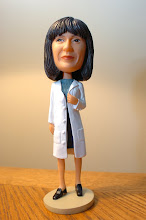Proteins play a large role in so many of our body's functions. They are needed to synthesize tissues (muscles, connective) and enzymes, to maintain your acid-base and fluid balance, create plasma, antibodies, and clotting agents in your blood, produce hormones (thyroid, insulin) and manufacture light sensitive pigments in your eyes. Whew! Ok, that's not the entire list, but you get the idea - protein is important. Your body contains an estimated 10-50,000 different proteins, many of which are still being researched.
So, what is a protein? In a nutshell, it is a chain of amino acids. Need more detail? Ok. They are highly complex biopolymers comprised of carbon, hydrogen, oxygen and nitrogen. Still with me? You see, it's that nitrogen which sets them apart - both carbohydrates & fats are made up of carbon, hydrogen & oxygen, but no nitrogen. In fact, 'amino' means 'containing nitrogen'.
CHEMISTRY ALERT! (I've found its better to give a warning when covering the really sciency stuff. ) Chemistry 101: All carbon atoms must have 4 bonds, nitrogen 3, oxygen 2 and hydrogen 1. Hanging in there? All amino acids have three identical parts: they have connected to their central carbon atom an amino (NH2) group, an acid (COOH) group and a hydrogen (H). That leaves one more bond on the central carbon atom available. It is this side group and what it contains that makes each amino acid unique. To see protein's structure in 3D look here.
With 20 different major amino acids and a few minor ones, there are almost an infinite number of combinations (ok, maybe not quite that many, but a lot) that can be joined together to form proteins. Most proteins are made of chains of 100 to 300 amino acids. Within these 20 amino acids, there are 9 essentials and 11 non-essentials. Now that protein has been defined as an organic biopolymer, essential to life as we know it, it is time to learn about complete proteins and protein scores and what standards are used to determine them. But that will be my next post!





No comments:
Post a Comment